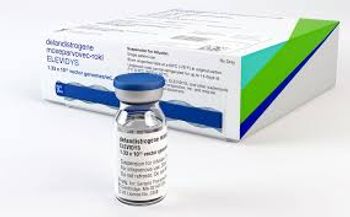
Transdermal rotigotine reduces motor symptoms in early Parkinson disease
A once-daily transdermal patch containing the dopamine receptor agonist rotigotine appears to be well tolerated, provides sustained relief from motor symptoms associated with Parkinson disease (PD), and has few dopaminergic adverse effects, particularly among elderly patients, reported Ray L. Watts, MD, and colleagues at the American Neurological Association 131st Annual Meeting, and Jack J. Chen, PharmD, and colleagues at the 2006 American College of Clinical Pharmacy Annual Meeting. Transdermal rotigotine is currently being reviewed by FDA for the treatment of early PD.
A once-daily transdermal patch containing the dopamine receptor agonist rotigotine appears to be well tolerated, provides sustained relief from motor symptoms associated with Parkinson disease (PD), and has few dopaminergic adverse effects, particularly among elderly patients, reported Ray L. Watts, MD, and colleagues at the American Neurological Association 131st Annual Meeting, and Jack J. Chen, PharmD, and colleagues at the 2006 American College of Clinical Pharmacy Annual Meeting. Transdermal rotigotine is currently being reviewed by FDA for the treatment of early PD.
"The patch may help delay levodopa use in early-stage PD and has a low risk of dyskinesia," Dr Watts and colleagues said. Dyskinesia observed with other dopamine receptor agonists may be reduced with rotigotine because of the steady plasma levels delivered with the patch.
Dr Watts and colleagues presented safety and tolerability data from 3 pooled rotigotine trials including 938 patients with early PD of ≤3 years' duration and a Hoehn and Yahr stage score of <3. All patients had ≥2 motor symptoms (eg, bradykinesia, resting tremor, rigidity, postural instability). Patients were randomized to receive a 2-, 4-, 6-, or 8-mg rotigotine patch or placebo every 24 hours during a 4-week titration phase and a 24-week maintenance phase.
Among patients aged ≥75 years (rotigotine, n=47; placebo, n=32), the dopaminergic side effects of nausea, vomiting, and hallucinations were less frequent than among younger patients. According to the authors, "These data indicate that transdermal rotigotine may be a useful treatment option not only for younger PD patients but also for those over age 75, a patient subpopulation in which it has been common clinical practice to avoid dopamine agonist therapy."
Phase 3 efficacy data presented by Dr Chen and colleagues demonstrated that rotigotine significantly reduced motor symptoms in patients with early PD. All patients in the 4 included trials had PD of ≤5 years' duration, a Unified Parkinson's Disease Rating Scale (UPDRS) motor function score of ≥10, and a Hoehn and Yahr stage score of ≤3. Patients received a ≤8-mg rotigotine patch every 24 hours during a 4-week titration and 24-week maintenance phase. Concomitant treatment with levodopa was not permitted. The primary end point was change in the UPDRS subtotal.
One trial of 177 patients with early-stage PD who were randomized to rotigotine demonstrated a mean decrease of 3.98 UPDRS points versus an increase of 1.31 points for the 96 placebo patients (P<.0001). A second trial demonstrated a mean decrease of 6.83 points for rotigotine patients (n=213) versus a mean decrease of 2.33 points for placebo patients (n=117; P<.001). The improvement in motor symptoms was comparable to that seen with ropinirole, said Dr Chen and colleagues.
In trials of late-stage PD, rotigotine significantly reduced "off" time with breakthrough motor symptoms and increased time without dyskinesia among patients with PD of ≥3 years' duration whose symptoms were insufficiently controlled with levodopa.
In 1 late-stage trial, 202 patients received ≤16 mg rotigotine every 24 hours, 200 received pramipexole, and 100 received a placebo patch during a 4-week titration phase followed by a 16-week maintenance period. There was a mean decrease in "off" time of 2.44 hours, which was comparable to a 2.82-hour reduction among pramipexole patients. Placebo patients had a mean decrease of 0.88 hours (P<.001). Mean increase in time without dyskinesia was 3.06 hours for rotigotine, 2.98 hours for pramipexole, and 1.49 hours for placebo (P=.0003). In another trial, late-stage patients receiving an 8-mg rotigotine patch experienced a 2.7-hour decrease in "off" time (P=.001) and a 3.36-hour increase in time without dyskinesia (P=.0001) versus placebo. Patients receiving a 12-mg patch experienced a 2.1-hour decrease in "off" time (P=.003) and a 2.39-hour increase without dyskinesia (P=.0078).
SOURCES Watts RL, Patton JM, Poewe W, Boroojerdi B. Safety and tolerability of transdermal rotigotine in early-stage Parkinson's disease [abstract]. Presented at: American Neurological Association 131st Annual Meeting; October 8–11, 2006; Chicago, Ill. Abstract T-48.
Chen JJ, Langston JW, Jankovic J, Chang FL. Transdermal rotigotine: Evaluation of efficacy and continuous drug delivery in Parkinson's disease [abstract]. Presented at: American College of Clinical Pharmacy Annual Meeting; October 26–29, 2006; St. Louis, Mo. Abstract 174.
Newsletter
Get the latest industry news, event updates, and more from Managed healthcare Executive.

















































